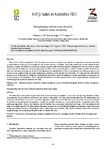| dc.contributor.author | Mantoani, Laura | |
| dc.contributor.author | Pérez del Pulgar Mancebo, C.J. | |
| dc.contributor.author | Luque Polo, Gabriel | |
| dc.date.accessioned | 2023-10-09T13:33:04Z | |
| dc.date.available | 2023-10-09T13:33:04Z | |
| dc.date.issued | 2023 | |
| dc.identifier.citation | Mantoani, L., Perez-del-Pulgar, C.J., Luque, G. 2023. Path planning with far-away obstacles detection under uncertainty. XLIV Jornadas de Automática, 633-638. https://doi.org/10.17979/spudc.9788497498609.633 | es_ES |
| dc.identifier.isbn | 978-84-9749-860-9 | |
| dc.identifier.uri | http://hdl.handle.net/2183/33652 | |
| dc.description.abstract | [Resumen] Hoy en día se están investigando robots de exploración terrestre y espacial más rápidos en respuesta a la creciente demanda de capacidades de exploración e investigación más rápidas, eficaces y rentables. Para estas plataformas móviles rápidas la identificación y evasión de obstáculos lejanos son críticas, ya que su alta velocidad implica la necesidad de tener en cuenta el mayor número posible de obstáculos cercanos y lejanos para el cálculo de la trayectoria global, evitando cualquier posible accidente debido a su velocidad y al tiempo de cálculo de los algoritmos de replanificación. Debido a su distancia, los obstáculos lejanos no se incluyen en los mapas locales, que están limitados por el alcance de las cámaras de profundidad. Por estas razones, este artículo propone el uso de técnicas de Inteligencia Artificial para detectarlos a partir de imágenes y estimar sus tamaños y posiciones con un cierto grado de incertidumbre. Los obstáculos detectados se incluirán posteriormente en los mapas globales, corrigiendo la trayectoria global en caso de colisionar con ellos. | es_ES |
| dc.description.abstract | [Abstract] Nowadays faster terrestrial and space exploration robots are being investigated, in response to the growing demand for faster, more efficient, and cost-effective exploration and research apabilities. For these rapid mobile platforms, the identification and avoidance of far obstacles are critical, since their high speed implies the need to take into account as many near and far obstacles
as possible for the global path computation, avoiding any possible accident due to their speed and the computation time of the replanning algorithms. Due to their distance, the far obstacles are not included within the local maps, which are limited by the range of the depth cameras. For these reasons, this paper proposes the use of Artificial Intelligence techniques to detect them from images and estimate their sizes and positions with a certain degree of uncertainty. The detected obstacles will be later included in the global maps, correcting the global path in case it collides with them. | es_ES |
| dc.language.iso | eng | es_ES |
| dc.publisher | Universidade da Coruña. Servizo de Publicacións | es_ES |
| dc.relation.uri | https://doi.org/10.17979/spudc.9788497498609.633 | es_ES |
| dc.rights | Attribution-NonCommercial-ShareAlike 4.0 lnternational (CC BY-NC-SA 4.0) https://creativecommons.org/licenses/by-ncsa/4.0/ | es_ES |
| dc.rights.uri | http://creativecommons.org/licenses/by-nc-sa/3.0/es/ | * |
| dc.subject | Sistemas robóticos autónomos | es_ES |
| dc.subject | Guiado navegación y control | es_ES |
| dc.subject | Robótica inteligente | es_ES |
| dc.subject | Robots móviles | es_ES |
| dc.subject | Percepción y detección | es_ES |
| dc.subject | Autonomous robotic systems | es_ES |
| dc.subject | Guidance navigation and control | es_ES |
| dc.subject | Intelligent robotics | es_ES |
| dc.subject | Mobile robots | es_ES |
| dc.subject | Perception and sensing | es_ES |
| dc.title | Path planning with far-away obstacles detection under uncertainty | es_ES |
| dc.type | info:eu-repo/semantics/conferenceObject | es_ES |
| dc.rights.access | info:eu-repo/semantics/openAccess | es_ES |
| UDC.startPage | 633 | es_ES |
| UDC.endPage | 638 | es_ES |
| dc.identifier.doi | https://doi.org/10.17979/spudc.9788497498609.633 | |
| UDC.conferenceTitle | XLIV Jornadas de Automática | es_ES |






